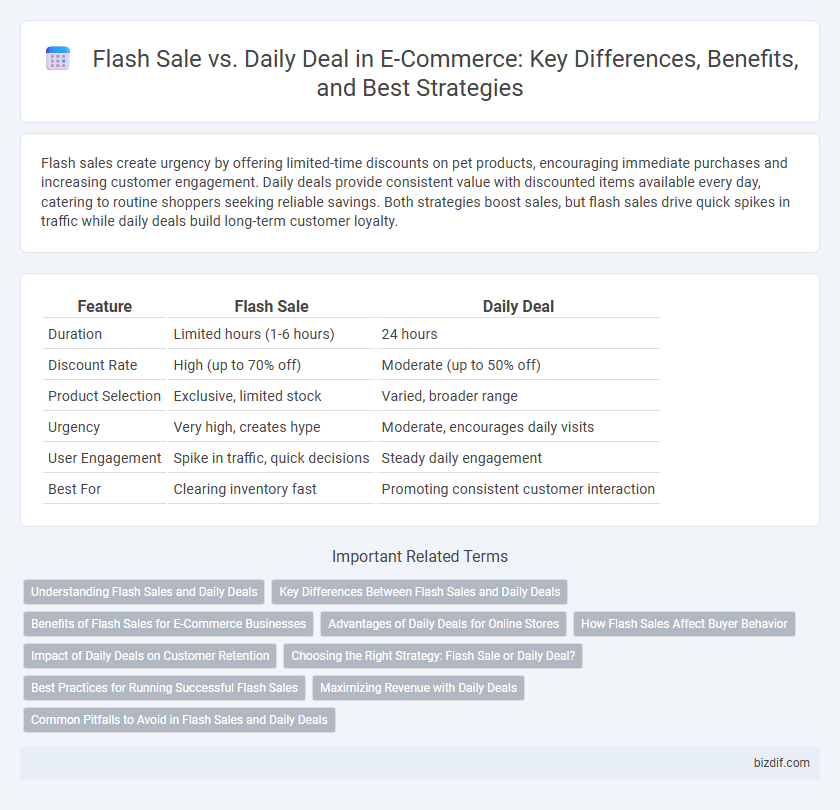Flash sales create urgency by offering limited-time discounts on pet products, encouraging immediate purchases and increasing customer engagement. Daily deals provide consistent value with discounted items available every day, catering to routine shoppers seeking reliable savings. Both strategies boost sales, but flash sales drive quick spikes in traffic while daily deals build long-term customer loyalty.
Table of Comparison
| Feature | Flash Sale | Daily Deal |
|---|---|---|
| Duration | Limited hours (1-6 hours) | 24 hours |
| Discount Rate | High (up to 70% off) | Moderate (up to 50% off) |
| Product Selection | Exclusive, limited stock | Varied, broader range |
| Urgency | Very high, creates hype | Moderate, encourages daily visits |
| User Engagement | Spike in traffic, quick decisions | Steady daily engagement |
| Best For | Clearing inventory fast | Promoting consistent customer interaction |
Understanding Flash Sales and Daily Deals
Flash sales are limited-time promotions offering steep discounts on selected products, designed to create urgency and boost quick customer purchases. Daily deals feature special offers available for an entire day, providing consistent opportunities for shoppers to save while encouraging daily website visits. Both strategies aim to increase sales volume and enhance customer engagement through time-sensitive pricing.
Key Differences Between Flash Sales and Daily Deals
Flash sales feature limited-time discounts, often lasting only a few hours, creating urgency and driving rapid purchases, while daily deals offer special prices valid for an entire day, appealing to shoppers seeking flexibility. Flash sales typically highlight high-demand products with steep discounts to clear inventory quickly, whereas daily deals provide consistent savings across a broader product range to maintain steady traffic. The immediacy and exclusivity of flash sales differentiate them from daily deals, which emphasize convenience and sustained promotional engagement.
Benefits of Flash Sales for E-Commerce Businesses
Flash sales generate urgency and drive rapid spikes in traffic, significantly increasing conversion rates for e-commerce businesses. These limited-time events create a buzz that boosts brand visibility while encouraging impulse purchases and clearing out inventory efficiently. Leveraging flash sales can enhance customer engagement and foster loyalty through exclusive, time-sensitive offers.
Advantages of Daily Deals for Online Stores
Daily Deals offer online stores a consistent way to attract and retain customers by providing regular, limited-time discounts that create urgency without overwhelming buyers. These deals enhance inventory turnover and improve cash flow by encouraging repeat purchases, boosting customer loyalty, and increasing average order value. Furthermore, Daily Deals enable targeted marketing strategies and personalized promotions, optimizing customer engagement and driving sustained revenue growth.
How Flash Sales Affect Buyer Behavior
Flash sales create a sense of urgency that drives immediate purchasing decisions, leveraging limited-time offers to boost conversion rates rapidly. This time-sensitive pressure often leads to impulse buys and higher average order values compared to daily deals, which typically provide ongoing moderate discounts without urgency. E-commerce platforms use flash sales strategically to clear inventory quickly, increase customer engagement, and stimulate repeat visits.
Impact of Daily Deals on Customer Retention
Daily deals create a sense of urgency and excitement that encourages frequent visits and repeat purchases, significantly enhancing customer retention rates. By offering limited-time discounts on popular products, e-commerce platforms foster brand loyalty and increase the likelihood of customers returning for future deals. The strategic use of daily deals leads to higher engagement and sustained revenue growth compared to one-off flash sales.
Choosing the Right Strategy: Flash Sale or Daily Deal?
Flash sales create urgency by offering steep discounts for a limited time, driving rapid spikes in traffic and conversions, ideal for clearing inventory quickly. Daily deals provide steady customer engagement with moderate discounts, fostering brand loyalty and consistent sales over time. Selecting the right strategy depends on your inventory goals, customer behavior analytics, and promotional calendar to maximize revenue and customer retention in e-commerce.
Best Practices for Running Successful Flash Sales
Executing successful flash sales requires precise timing, limited inventory, and clear urgency to drive instant purchases. Leveraging real-time analytics to monitor customer behavior and adjust pricing or promotions ensures maximum conversion and minimizes stockouts. Integrating seamless mobile payment options and targeted marketing through email and social media boosts engagement and accelerates sales velocity.
Maximizing Revenue with Daily Deals
Daily Deals generate consistent customer engagement by offering limited-time discounts that encourage frequent visits, driving steady revenue streams. Unlike Flash Sales, which create short bursts of high traffic, Daily Deals foster long-term loyalty and higher average order values through relatable, ongoing promotions. Optimizing product selection and timing in Daily Deals maximizes sales without overwhelming customers, sustaining profitability over time.
Common Pitfalls to Avoid in Flash Sales and Daily Deals
Flash sales often suffer from poorly timed promotions and insufficient inventory management, leading to customer frustration and lost sales opportunities. Daily deals commonly face issues with inadequate audience targeting and unclear discount communication, reducing their effectiveness in boosting conversions. Avoiding these pitfalls requires precise planning, real-time stock updates, and transparent messaging to maximize customer engagement and revenue.
Flash Sale vs Daily Deal Infographic

 bizdif.com
bizdif.com